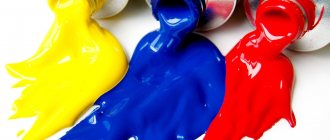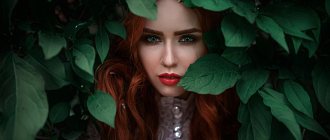Black is neither a chromatic nor a spectral shade. It has been proven to have an effect on people. The color black in psychology usually does not have a strong negative connotation. On the one hand, strength and rigidity are associated with this shade, on the other – the desire for loneliness and isolation.
Black is a symbol of perseverance
Nature is black
Colors are light waves of different lengths that are perceived by human vision and displayed as different shades. Black can be defined as the absence of color at all, since darkness does not reflect light flows, but absorbs them.
On the other hand, artists claim that black is a combination of all possible colors together, which gives many variations of shade: from blue-black to reddish, from charcoal to gray.
Various compounds are used as pigments for black, which are subjected to heat treatment:
soot, obtained after burning the seeds of certain plants (grapes, peaches) burnt bone or bone black, made from charred animal bones black mars, created by oxidizing and burning iron oxide
Natural pigments for black paint are graphite and magnetite, and organic pigments are black aniline and nigrosine.
Story
The path of the most controversial and mysterious shade, starting from the era of Ancient Rome and ending with the beginning of the third millennium, was traced by the French historian Michel Pastoureau in his monograph “Black. History of color".
People have always been afraid of the dark. All fairy tales and legends, myths and beliefs about monsters and inhabitants of the underground Hell are associated with the color black. In Pastoureau's book, this is succinctly described with the words: “Emerging from darkness, life took shape.” With the development of intelligence and skills, man found a reliable ally in the fight against the blackness of the night - fire. With its help they prepared food, drove away wild animals, and heated homes. At the same time, by burning at fires, ancient people learned to produce artificial dyes: soot, charred tree branches, coal. Then a use was found for the seeds of fruit trees, bark, and nut shells.
Using these primitive “paints” to create rock frescoes, people noticed differences between different types of materials. This is how the black color acquired its first characteristics: shine, texture, density. During antiquity, these shades acquired their first names. So, shiny black was called niger, and matte - ater.
Over time, the term ater became synonymous with something dirty, obscene, repulsive, while niger, on the contrary, received a more positive meaning
In the early Middle Ages, black color was found in the form of separate elements on the coats of arms and banners of knights, in the clothing of merchants and artisans, in the vestments of the highest nobility and courtiers. Still considering this shade a symbol of danger and mystery, people attributed mystical properties to it, creating legends about invincible Black creatures - from robbers to ghosts.
Closer to the 13th century, in the wake of the hunt for witches and sorcerers, ministers of the church and the Holy Inquisition switched from brown robes to black dresses and capes. And after them, representatives of the nobility appreciated the severity and versatility of this shade. Dark robes became an indicator of spirituality and high morality. Black fabrics were highly valued and expensive.
The rapid development of culture at the end of the Middle Ages introduced black elements into painting and mosaic frescoes - more and more artists and craftsmen took dark shades as a basis and used them to express contrasts.
During the Renaissance, cloth became more and more accessible: now clothes in dark colors represent peasants and slaves - black power. And thanks to the great Leonardo Da Vinci, who created the doctrine of the six primary colors of the spectrum, painters begin to comprehend their art as a struggle between light and darkness.
Later, black tones became a symbol of romanticism and were again loved by aristocrats: in Holland, for example, the richest and most luxurious wedding dress was black, made of silk and twill, complemented by white lace embroidery on the collar and sleeves.
In the 18th and 19th centuries, black, along with its other shades, became ubiquitous - from uniforms and craft clothing to elegant dresses of ladies from secular society and the robes of representatives of the highest clergy. At the same time, this color becomes the main symbol of mourning and sadness.
The beauty of black: dispelling all negative associations
Unfortunately, no matter how beautiful a dark shade is, there will always be people who associate dark color only with negative emotions. To avoid negative associations, simply present black in a positive light. Each color in the color palette is beautiful in its own way and the color of night is no exception.
The dark shade is preferred by many famous Hollywood models and actresses.
Agree, would they wear something that is associated with death? No, instead we see them resplendent in elegant dark dresses on the red carpet of fame. A fashion designer such as the French woman Coco Chanel loved dark color and created stunning outfits with its help, which are still considered the standard of grace today.
Symbolism of black color
Associations that arise when mentioning the color black are as diverse as its shades. It is shrouded in mysticism and secrets, it frightens with the unknown and bottomlessness, it leads you into the world of nightmares and awakens the imagination.
What did black mean in ancient times?
The culture of every nationality will definitely have its own attitude towards black:
In ancient Mexico, during sacrifices, priests smeared their faces and hands with soot, wanting to please the gods.
The African religion of voodoo requires the killing of only black animals for rituals.
In some equatorial countries it is still believed that women with pitch-black skin have unbridled temperament, including sexual ones.
In India, this shade was associated with mother earth and at the same time was responsible for oppression. Therefore, servants in this country always wore dark clothes.
In ancient China, black was considered one of the most important symbols of strength and spirituality, and in Japan - nobility.
In Christianity, black was associated with the color of the devil, vice and death, but gradually it acquired a second meaning of humility, the desire to be freed from earthly sins and turned into the “calling card” of monasticism
In the culture of primitive people, black was the main color and was opposed to white: day - night, life - death, purity - dirt, order - chaos, good - evil. Therefore, all magical and religious rituals, especially among African peoples, were based on the use of black. For example, in Zambia, during the Ndembu ceremony, the color black could mean:
evil deeds, bad things, illness and imminent death, witchcraft, damage, loss of luck, ritual death, darkness, sexual desire
In a number of European countries, this color was a symbol of protection from the evil eye. It was believed that if a person, animal or inanimate object has black marks on itself, it is not worthy of envy. Therefore, dark dots were applied to the faces of newborns, animal fur was dyed, and black stones were placed under houses.
Also, the ancestors of modern Europeans were sure that black was a sign of witchcraft and witches. The homes of people suspected of magic and divination were marked with black paint. And the expression “he has a black liver” meant the nasty, bad and evil intentions of a person.
The personification of dark forces through the color black can be traced not only in the mythology and beliefs of peoples, but in literature and painting. Characters who bring threat and death are presented by the authors as carriers of darkness in any form: clothing in dark colors, black hair and eyes, black amulets and jewelry.
Symbolism of black in modern society
The color black retains its gloomy traditional meanings today. The main negative symbols remain:
death, illness, mourning, sadness, sadness, evil, misfortune, misfortune, dirt, meanness, violence, loss, bereavement, sorrow
But not all associations are negative: black is considered the sexiest and most mysterious color. It symbolizes looseness in sexual relations and awareness of one’s desires.
Also, black color attracts various subcultures. Using clothes and accessories in dark shades, representatives of youth movements create their own model of behavior and characteristics that are different from other similar movements.
Black color can become a symbol of loneliness and melancholy, secret love and suffering, exorbitant luxury and oppressed poverty.
Each person puts their emotions and personal experience gained under certain circumstances into the meaning of the color black. For some people, this is a sign with a negative connotation after the loss of a loved one or failure in love, for others it is a symbol of tough decisions, freedom and will.
How does it affect people's psyche?
Red color in psychology - what does it mean for women and men
Man in a black suit
An interesting experiment was recently conducted. It was established that the thesis about “black and white logic” is not just a cliche and not just a common expression.
The floor in the judges' quarters was painted austere black. The judge, who had previously been known to be meticulous, impartial and fair, was inclined to convict.
The experiment was repeated again. This time the process took place in a room with a white floor. After considering the case, the judge pronounced an acquittal.
Therefore, psychologists have concluded: the color black really has a strong effect on the human psyche.
This shade has long been associated with darkness and gloom. The expression “seeing the world in black and white” is widely known. However, society associates a black limousine with luxury and glitz. In the middle of the 20th century, it was proven that the “color of evil” is not black, but brown - it was this shade that was chosen by the SS stormtroopers.
Attitudes towards blacks have softened. According to a number of psychologists, this is the color of extraordinary, organized people. Therefore, it is often used in the interior of large companies.
Absorbing the entire color spectrum, black includes all the healing qualities of other shades. It is not recommended to abuse it - it helps to lower your mood.
You should be wary if a person has suddenly changed his habits. It is recommended to take a closer look at his behavior and, if necessary, seek help from a qualified psychologist-psychotherapist.
The meaning of black color in psychology
Being a “science of the soul” and the principles of its development, psychology cannot have a single point of view on the meaning of black for a person. The perception of it is determined in each specific case, taking into account the circumstances and psycho-emotional state of the person.
Commitment to this color may mean a desire to retire, hide from the annoying outside world and indulge in one’s thoughts, which can lead to the development of depressive states. Also, black shades can signal an intention to commit a crime or the presence of thoughts of doing something beyond the scope of generally accepted morality.
Black color is the favorite self-expression of gangsters and street hooligans. It symbolizes strength, power and helps to remain unrecognized under cover of night.
In another case, the choice of this color is an indicator of internal struggle, perseverance in an attempt to maintain one’s position.
An indicative example of the desire to understand the philosophy of black color is the famous work of Kazimir Severinovich Malevich “Black Square”. Despite the name, the artist painted his picture with a variety of colors. The layering of all possible shades helped achieve such a deep and captivating image. It was assumed that in the process of looking at the black square, people would subconsciously see a multi-colored cube, signifying the versatility of life. Although some admirers of painting still consider this painting to be a stupid idea that carries no meaning, many note the clear depressing effect of the painting on the mood. Malevich himself, after completing his work, experienced difficulty sleeping for several weeks, which indicates depression and powerlessness.
For men
As a rule, men are less susceptible to public displays of feelings; they are more restrained and focused inside their world. Therefore, in most cases, the color black is perceived simply as a certain shade. Men do not look for hidden meaning in the clothes or household items they purchase; they rely on personal taste, socially accepted rules and convenience.
For example, official meetings and celebrations require a certain dress code. The overwhelming number of men will choose a classic dark suit not because they gravitate towards loneliness and suffer from gloomy thoughts, but because it is customary, comfortable and familiar.
Interior
- Undiluted black, except in rare cases, is not used in interior design. It is impossible to stay in such a room for a long time due to the fact that the nervous system is depressed, feelings of being driven into a corner arise, the person becomes aggressive and irritable, emotionally unbalanced, negative thoughts and negative emotions appear.
- It is unacceptable to use this color in the bedroom and children's room, as well as in the kitchen and living room. An exception may be the bathroom and toilet.
- When there is a desire to emphasize something, black can be used. However, to balance the background color, it is important that it be combined with beige or white.
- With a golden tint - pretentious.
- With yellow - extravagant and prestigious.
Negative effects of black
It is impossible to assess the influence of the color black on a person’s psycho-emotional state without taking into account his initial position. Someone who has recently suffered mental trauma will see everything that surrounds him in dark colors. And the presence of black color will have an additional depressing effect. A person who is in an excellent mood will not lose vigor and good mood when interacting with black shades.
However, positive perception can be distorted if there are initial prerequisites:
health problems failures in work, business quarrels, misunderstandings with loved ones love experiences interpersonal conflicts self-doubt emotional exhaustion
Fear of the dark can also play a role: a person who experiences anxiety when night falls or when the lights are turned off will subconsciously avoid the color black and its derivatives.
The abundance of black colors in clothes and interiors can give rise to high anxiety, which manifests itself in frequent waking up and inability to sleep. This condition can be accompanied by unreasonable fears for the life and health of family members, constant checks like “Did I turn off the iron?” At the same time, changing the surrounding color scheme to a lighter or brighter one reduces the feeling of anxiety.
Where and when is black appropriate?
For example - at a party. Wear a simple little black dress and you will certainly not go unnoticed. Black also works great as a contrast color: for example, a black skirt and a red blouse (T-shirt).
You should avoid this color at christenings, weddings, and holidays. Don’t keep black very close to your face: this color “takes away” its vitality. Give up black if you work for television: black seems to “cut off” the body from the head and all the attention of the audience from the face (for example, the presenter) is switched to clothes. Be careful with the color black even when you want to meet a man: representatives of the stronger sex will be afraid to approach a stranger dressed in black, because this color maintains distance.
Almost every day we see crowds of teenagers dressed all in black on the streets of the city. With this color they show others their reluctance to be part of society.
The funny thing is that the color black can instantly turn from a sign of belonging to society into a sign of an outsider (outcast).
Shades of black
Although the name “black” is singular, there are a huge number of shades. The same color can be reflected differently when the lighting changes. Artists play magnificently on this ability of black, applying colors and shadows in such a way that each person sees them in their own way.
Gradations of black depend on density, texture, original pigment, gloss, transparency, various additives and a number of other factors. There are several main shades:
Coal black or silicon color is deep and rich, with a gray shiny tint. Reminds me of burnt wood. It was first used as a definition of hue in 1606.
Ox's blood is bright, shiny with a reddish tint. This shade is popular when coloring hair.
Blue-black - juicy, resinous with a bluish sheen. In the old days, this color was called the raven's wing, which is associated with the iridescence of the crow's plumage under sunlight.
What does your favorite color say about a person?
The choice of the most preferred color among the many existing shades has long been explained by fashion trends, culture, or simply differences in taste.
In the 20th century, this phenomenon began to be seriously studied by scientists working in the field of psychology and physiology. It turned out that the same shade can both attract and repel different people, depending on the individual personal characteristics of each of them.
Favorite color of a person and his character
Color preferences can be stable throughout life, or they can change. It depends on the person and his current internal state and life experiences.
By focusing on the color preferences of a friend, you can learn a little more about his mentality, emotionality, personal experiences and individual character traits.
For example, choosing one of the cool shades characterizes a person as calm and conservative. And warm tones are chosen mainly by cheerful, active and emotional individuals.
We offer you to take a short test, with the help of which determining a person’s psychotype will not be difficult.
Combination with other colors
In terms of interaction with other shades, black is universal. It goes well with any color in clothing, interior design, jewelry, and advertising. Some combinations remain constant for a long time, for example, the classic dress “white top, black bottom.” This business combination is used in educational institutions and official state companies. Another familiar option is the yellow-black tandem, which is very memorable.
Black is a unique way of expressing contrasts: any other color will appear sharper and more saturated against a dark background. Soft pink, lilac, beige, gray shades in combination with black acquire expressiveness, and bright green, blue, yellow, purple tones will sparkle with new colors.
Who likes this color
Purple color in human psychology - what does it mean who likes it?
It is believed that depressed people who are constantly in a depressed, depressed state may like this shade. This is not entirely true. Successful entrepreneurs and representatives of show business dress in black.
The cassock of Orthodox and Catholic priests is black. In the recent past, schoolgirls wore uniforms of this color. Before the revolution, governesses and teachers dressed in black.
A person can give preference to this shade without experiencing any negative emotions. Sometimes his choice indicates a desire to focus on creativity or self-realization.
Black is a rich, rich color. It is associated with mystery and mystery. It is no coincidence that black and white films arouse more interest among the viewer than bright color films.
Lovers of black
There is no single definition of character for lovers of black: a lot depends on a person’s temperament, his environment, sphere of activity, environment of upbringing - each factor is significant and leaves its mark. But there are several classic options:
Fighter
This is a person who knows his capabilities and soberly assesses reality. He tries to go towards his intended goal, despite obstacles and failures. By choosing black, he emphasizes willpower, diligence and the desire to succeed in spite of everything.
Ruler
Such people strive to command and control all aspects of both their lives and the existence of those around them. They are strong in spirit, well erudite, and know how to stand their ground. At the same time, they are conflicting, irreconcilable to other people’s opinions, and always like to remain right.
Closed personality
This person is reasonable, calm in appearance, speaks little, prefers solitude and does not attend noisy companies. However, he is internally ambitious and loves to be appreciated. Such people do an excellent job at their job, slowly but surely climb the career ladder and have at most a couple of good friends.
King
This type is easy to recognize by its demeanor - authoritative, slightly arrogant, but at the same time friendly. Such people like to dress smartly, surround themselves with beautiful and expensive things, and flaunt their wealth. At the same time, a person of this type easily helps others, does not humiliate, and does not demand recognition. However, he does not forget to remind about his merits.
Peculiarities of perception
Each color carries certain information about the world around us, since everything we see has its own specific forms and conveys certain information. Black color, unlike other colors, does not emit waves: neither long nor short.
It seems to absorb our perception and direct it somewhere into the very depths of consciousness.
Black is rightfully considered the most mysterious color. It affects the human psyche differently than other colors. Even gray can evoke many positive emotions, but black is almost always associated with a bad state of mind.
Psychologists have learned to use this well.
Using tests that use color coloring, they determine the level of depression. Children's fears are identified in this way. When a child paints a picture and uses only dark tones, then the alarm should be sounded. Such drawings mean that the baby is experiencing stress.
The perception of black color may increase or, conversely, decrease. It depends on the psychophysiological state of the person. To improve the internal situation, specialists use color therapy.
To do this, they take bright colors (yellow, green or orange), which contribute to the complete restoration of mental balance, and contrast them with black.
The destructive nature of black can be redirected to creation. To begin with, you can invite a person to write letters (preferably hieroglyphs) on white (or yellow) paper with black paint. Then gradually change the black tone by reducing it. Smoothly switch to a gray shade, and then to a more life-affirming one.
So, imperceptibly, a person’s consciousness begins to tune in to the desired mood.
He forgets about losses and poor health. Anyone who prefers to mourn, after certain psychological manipulations, begins to “open” the soul to the perception of positive emotions.
Personal color perception must be taken more than seriously. Perhaps this way you will prevent low-grade depression in your loved one.
If you leave everything as is, a certain person may develop a very severe form of depression.
Use in clothing
Black is the most popular shade of clothing around the world. It is practical, comfortable, beautiful. Uniforms and business suits, dresses, trousers, blouses and shirts, coats and jackets of this color are bought every year on an almost industrial scale. However, the opinion that it is universal and suitable for everyone is wrong. Black color in clothes can highlight imperfections:
enhance shadows and circles under the eyes add age make incorrect proportions of the figure more obvious create an overly gloomy and unsociable image add fatigue and a feeling of staleness
By constantly choosing black clothes, people can unconsciously signal their state of mind. This may be a search for oneself, a desire to get away from the past or, on the contrary, to return to a certain state. A person who prefers black to other colors may be in a borderline state between “yesterday and tomorrow,” when life requires a serious radical decision from him. Dark clothing can be a way of self-expression, an indicator of renunciation of one's principles. It can symbolize a rethinking of your position in the world and the search for new opportunities.
The color black in clothes can serve as a sign of hidden aggression and anger, a desire to hide one's true intentions. Also, this color is capable of subconsciously setting others up for submission.
Characteristic
- Persistence. The ability to withstand the blows of fate and continue moving forward. Such a person is distinguished by perseverance and perseverance.
- Oppression. This color is gloomy, devoid of light. No wonder it is preferred by people who are depressed.
- Straightforwardness. A person who prefers the color black will not act pretentiously, will not lie, and will always tell the truth, even if it is inappropriate. It may be uncomfortable to be around such an individual, but you will never have the feeling that there is a two-faced person nearby.
- Depth. Such an individual behaves ambiguously. You never know what is hidden in it.
- Charismatic. Despite the fact that there is no brightness, this color attracts attention and allows you to win people over. Individuals whose favorite color is black can charm without much effort and conquer their interlocutor.
- If a person constantly surrounds himself with black things and concentrates his attention on them, this indicates a desire to be alone, in a state of peace and quiet, without communication and new acquaintances.
It has the following positive aspects:
- self confidence;
- achieving your goals;
- persistence;
- problem solving skills;
- creativity.
But negative aspects of color can also appear:
- prolonged depression;
- authoritarianism;
- depressed mood;
- selfishness.
Use in advertising
Knowledge of color psychology is successfully used by marketing and advertising specialists. By evoking certain associations and memories, the color black in the promotion of certain goods and services helps to increase demand.
For example, the unconscious correlation of dark shades with sophistication and prestige directs a potential buyer towards luxury products. This is used by both well-known brands of perfumes, clothing and shoes, cars and even food products, as well as start-up companies. Black shades in advertising products help convey information about the exclusivity of the product, its high status and quality to the desired segment of the population.
Mysticism and magic
When considering the question of what the color black means, one cannot fail to mention the secret side of life. Many witchcraft rituals cannot do without this tone. Black tablecloths, candles - all these are attributes familiar to many magicians. This color, of course, helps them. In addition, often people who practice magic themselves dress in dark colors. This helps them accumulate energy and direct it in the right direction. For example, in the 18th and 19th centuries, witches wore black pointed hats.
Such a headdress was not only part of the image, but also carried a hidden meaning. The pointed hat was a conductor that helped direct and concentrate witchcraft power.
The effect of black color on health
Colors can influence not only the human psyche, but also his health. Black, for all its elegance and beauty, can have a negative impact on your physical condition. A sick person subconsciously evaluates the color black as a symbol of failure, mourning, and ruthlessness, which negatively affects the healing process.
The predominance of dark colors in the environment and clothing can provoke a relapse of chronic diseases, give rise to a feeling of depression, oppression, and cause apathy, insomnia and neuroses.
At the same time, some people perceive black as a sign of concentration, a clear system, which allows them to concentrate on treatment, work or other important activities.
* * *
The influence of black on a person’s mental and physical state is as ambiguous and contradictory as the color itself. When assessing specific examples of exposure, there are many factors to consider, ranging from age, gender to hobbies, life experiences and environment.
Black is the child's favorite
The baby may experience a serious loss, the loss of a loved one, or the death of a beloved pet. At such moments, a love for black things and color often awakens. The kid withdraws into himself, begins to believe that he is an outcast, and prefers black clothes.
In subcultures such as goths, emo, black items are preferred due to their association with anarchism and exile. In such a situation, parents should begin to worry, since prolonged depression can have serious consequences. Love for black things is normal only in cases where there are no extremes.
If a child wears a black T-shirt, it is not an indicator that he has problems. It is possible that he is simply copying the hero of some movie and is sure that he looks cool.
Black in his drawing
When parents notice that their child has painted a picture using black, especially its abundance, they begin to worry. However, you need to take into account the fact that the choice of such a felt-tip pen or pencil may be determined by the contrast with the white sheet.
- A child may prefer black when he is three years old and going through a crisis. In this case, there will be negativism, stubbornness, and denial of parental authority. He may choose black when his parents offer him other colors, specifically to spite them.
- In adolescence, the color black can also be chosen in order to separate from the care of parents, to indicate individuality and independence.
- If parents notice the predominance of black in the drawings of their offspring, they should give him even more of their care and love, as well as wisdom and care.
- It is worth considering that black colors in their drawings are also chosen by those kids who have dark skin or brown eyes or black hair. In this way they simply show their temperament.
Now you know what black means. As you can see, this is not always a manifestation of darkness, mourning or misfortune. Well-chosen accessories will allow you to emphasize the advantages of a room or figure, and make an emphasis on something. Do not forget that the abundance of black in a child’s life can negatively affect his psyche.











